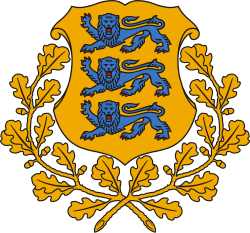Description
The coat of arms depicts a golden shield, which includes three slim blue lions passant gardant with red tongues in the middle and golden oak branches along both sides of the shield. The lesser coat of arms lacks these oak branches. The three lions on the national symbol of Estonia originate from the arms of King Valdemar II of Denmark who conquered northern Estonia in 1219. [1] [2] The lions became part of the greater coat of arms of Tallinn (Reval), the centre of Danish government in Estonia, and the fiefdoms (German: Ritterschaften) of Harria and Viru.
In 1346, the king of Denmark sold his Estonian dominion to the State of the Teutonic Order. The three lions, however, remained the central element of the greater coat of arms of Tallinn. In later centuries, the motif of the three lions transferred to the coats of arms of the Duchy of Estonia, the Estonian Knighthood, the Governorate of Estonia, and incorporated into the greater coat of arms of the Russian Empire. The Riigikogu (parliament) of the newly independent Republic of Estonia adopted the law which confirmed it as the national coat of arms on 19 June 1925. [1] [2]
During World War II, following the Soviet invasion and occupation of Estonia in June 1940, the display of the coat of arms, as well as of any other national symbols of Estonia, was banned by the new Stalinist regime. The symbols were replaced with Soviet-inspired emblems. The Soviet authorities persecuted anyone using the coat of arms or the national colours of Estonia. After World War II the coat of arms remained in use in the Western Bloc countries by a number of surviving diplomatic representatives of the Republic of Estonia, by the Estonian government-in-exile and by the large Estonian diaspora.
The coat of arms along with other national symbols were readopted on 7 August 1990, this marked one of the high points in the struggle for the restoration of the independent Estonian state which was eventually achieved on 20 August 1991. The use of the coat of arms is regulated by the Law on State Coat of Arms, passed on 6 April 1993. [1] [2]
This page is based on this
Wikipedia article Text is available under the
CC BY-SA 4.0 license; additional terms may apply.
Images, videos and audio are available under their respective licenses.
















